I recently completed building the Walthers Concrete Grain Elevator kit. It was a long build, for several reasons, and I made a number of mistakes. Let me walk you through how I built it and show you the mistakes I made.
“The only man who never makes a mistake is the man who never does anything” – Theodore Roosevelt
I’m calling this one a learning experience.
The kit comes in a large box and covers a footprint of 25cm x 13cm (approx. 9.8″ x 5.1″ or a scale 71.3′ x 37.1′) for the elevator itself and 23cm x 13cm (approx. 9.1″ x 5.1″ or a scale 65.6′ x 37.1′) for the silos. I list them separately because the silos are not attached to the elevator at all… much like real silos are built next to grain elevators and attached only with piping. The elevator is 34cm tall (approx. 13.4″ or a scale 97′ tall) and the silo complex with head house is 26cm tall (approx. 10.2″ or a scale 74′ tall).
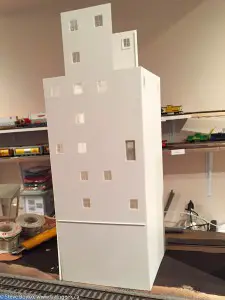
The grain elevator is a giant rectangular structure built out of four walls plus roof pieces. The first problem I had was gluing the sides together. I tried using CA (Cyanoacrylate) glue but it really didn’t work well, perhaps because the edges didn’t line up very well. I ended up using No-More-Nails and that worked much better. Thicker CA might have worked too.
The major problem I had at the start was making the building square! The kit walls basically meet just at the edges so there is nothing to keep your supposedly square base from turning into a parallelogram.
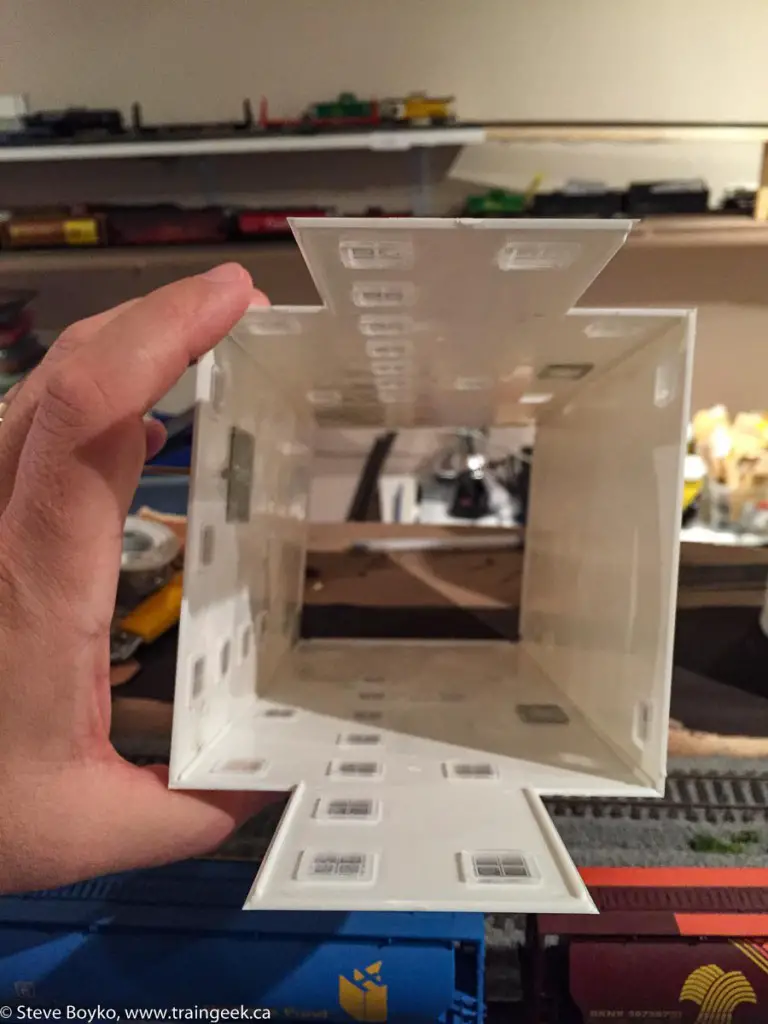
I really struggled with this. The building felt really flimsy, because of the edge gluing problem I had above, and I was concerned I was going to screw it up and end up with a misshapen monstrosity. I put the kit aside for quite a while until I found the solution.
I have to credit Ron Einarson, local modeler extraordinaire, for providing his wisdom to enable me to continue. I talked with Ron at the NMRA Canada open house late in 2014 and explained my problem. He suggested the use of gussets to square up the corners. What a great idea!
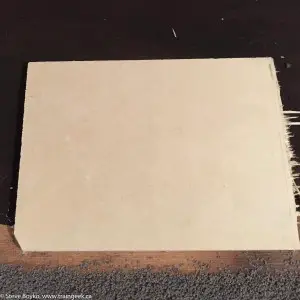
I adapted it a bit. I took a piece of wood and glued it to the layout to provide a square edge. You’ll notice I notched the corner to clear the little bit of lip at the joint inside the shell.
Once that was firmly attached to the layout, I applied No-More-Nails to two of the bottom edges of the grain elevator and stuck it down to the layout. I only applied the glue only to the two edges that would be on the base. I wanted the other two to float so I could square them up afterward.
[AdSense-A]
I put a few heavy objects next to the elevator to keep them pushed up against the base until the glue dried. No-More-Nails doesn’t take too long to dry.
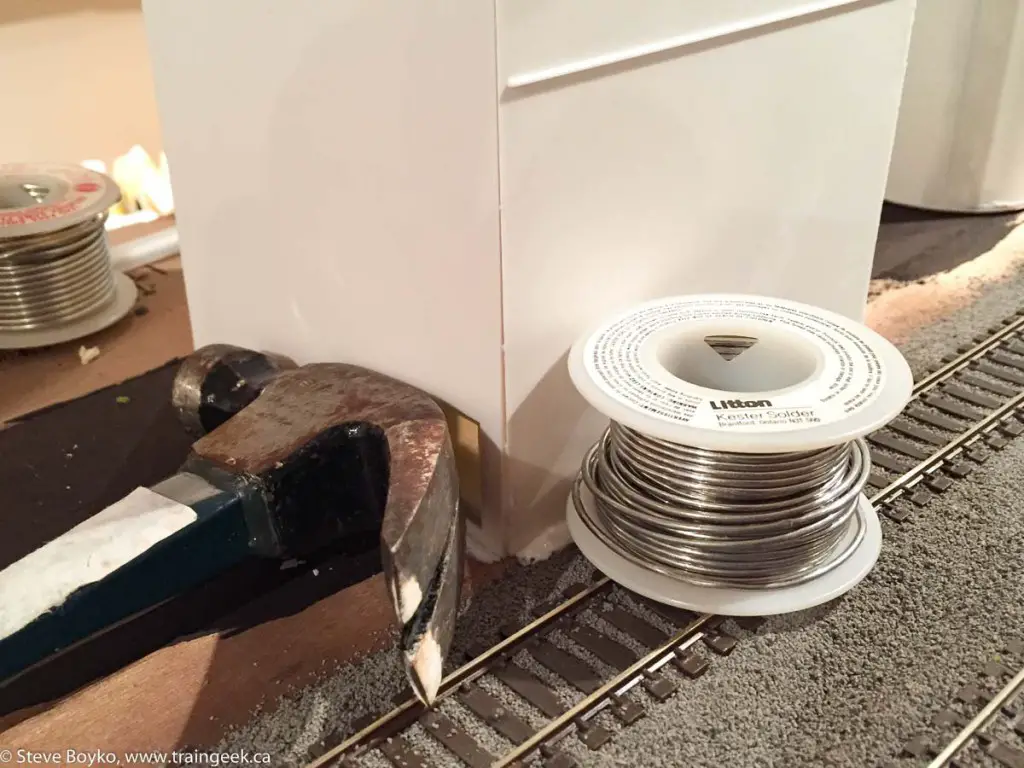
Once that dried, I squared up the opposite corner and glued it down too.
Soon afterward, I noticed my first and second major mistakes.
1. I hadn’t painted the elevator. And it was glued down.
2. I had already glued the windows in.
So. What to do?
Ideally I wanted to spray paint the elevator.
I could have ripped it off the layout, with a fairly high risk of breaking the elevator or at best separating it at the joints and starting again.
Since I had already glued the windows in, I’d have to mask every window before spraying… and then there’s the problem of the paint fumes in the train room, where I work every weekday. To me, spraying it in place was out of the question.
All I had left was to brush paint it. Not ideal.
So I painted it with a paint brush. It doesn’t look great close up but it’s OK at the 3′ viewing distance. Sigh.
I learned my lesson and took the silos, roof pieces and so forth out to the garage and spray painted them.
Once that was done, I carried on with assembly and built the head house on top of the silos, and glued the roofs on the top of the elevator. Here you can see how I was holding the pieces in place while the No-More-Nails dried.
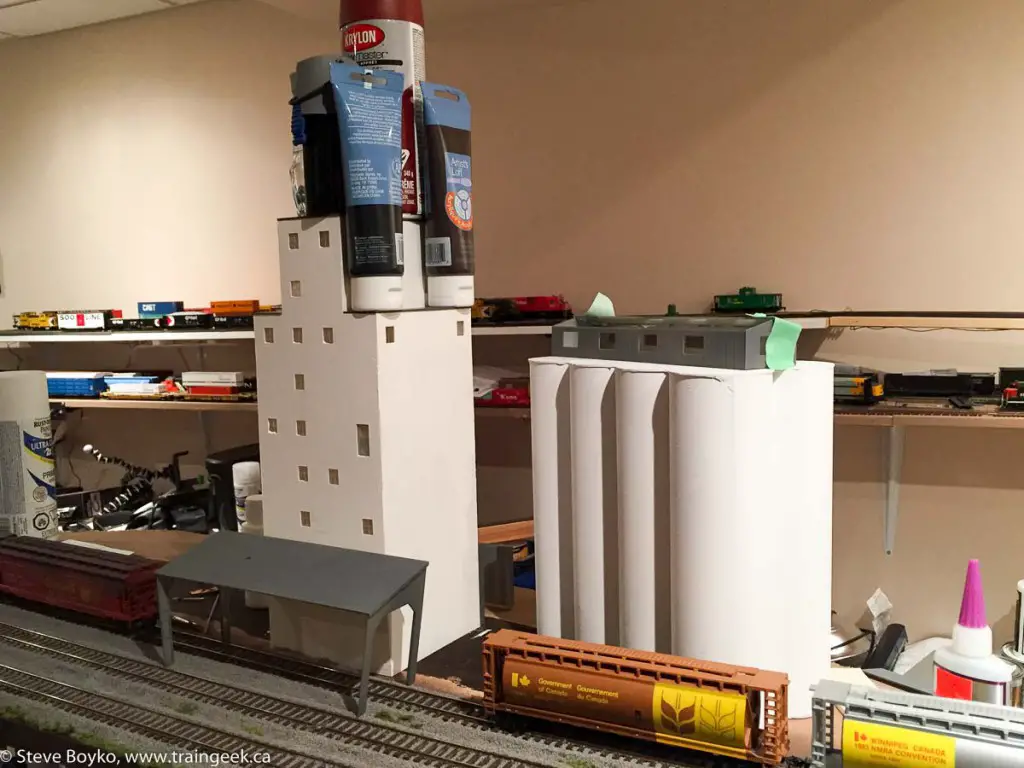
I installed the truck driveway on the back end. I glued the frame to the elevator and here I had glued the vertical wall on and was waiting for that glue to dry.
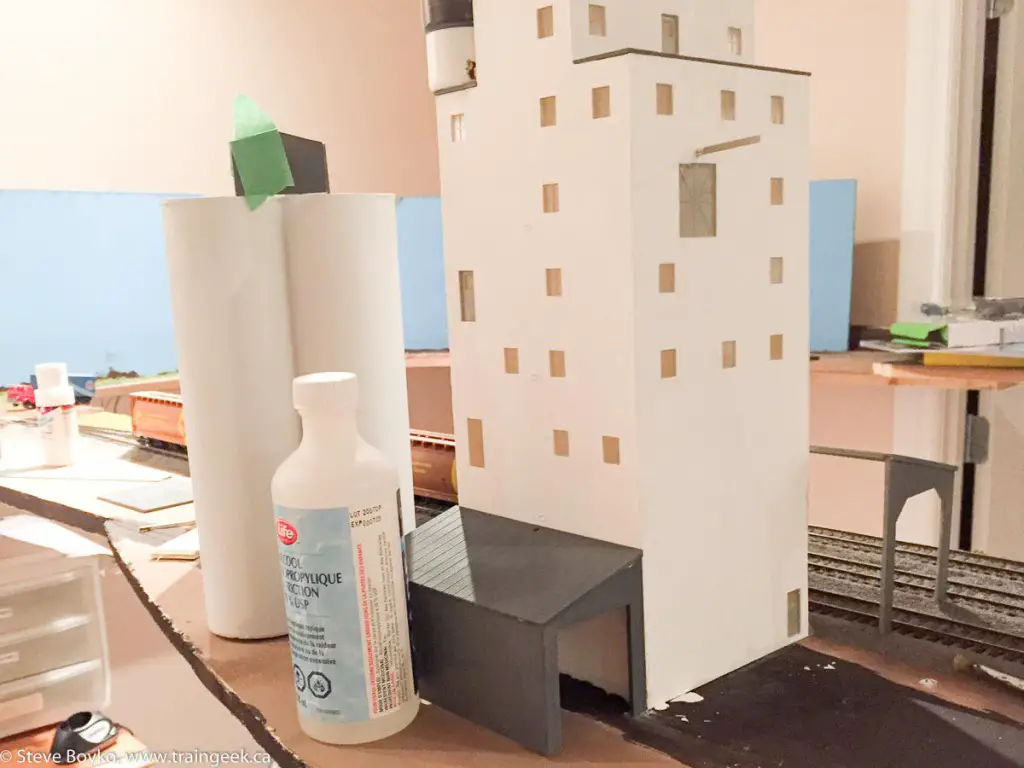
When I was building the head house, I noticed that you could look through the windows and see the emptiness inside and the backs of the windows on the other side. I decided to stick some junk in the middle to block the view and look vaguely like machinery.
I took a few blocks of foam and brush-painted them black, then glued them inside the head house with a little bit of silver piping from a refinery kit I never finished, from a previous layout..
It was then that I noticed a third mistake. You may have noticed it above the driveway two photos above.
3. I forgot to glue a door in.
The big problem is that they glue from the inside, and I had already glued the elevator down and glued the roofs on. There was no way to get into the elevator to glue it from the inside. I briefly considered some Mickey Mouse way of putting it in sideways, held with tweezers or something, then trying to pull it back into the right place but I decided there was a pretty high probability I would drop it inside.
I realized that the silos, not glued down to the layout, were covering over a large blank wall on the side of the elevator. I charged up my trusty Dremel and cut a hole in the side of the elevator before I thought too hard about what I was doing.
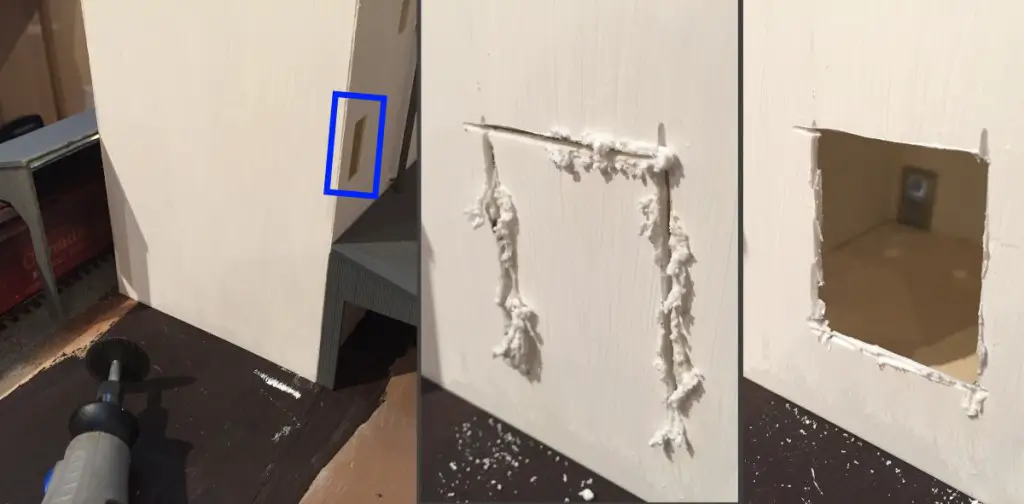
Once the hole was cut, it was easy enough to reach in and glue that last door. Now I also have a way in to put lights in should I decide to do that later.
I finished everything except the trackside shed and applied the Cargill decals that came with the kit. Note the rooftop dust collectors that came with the kit.
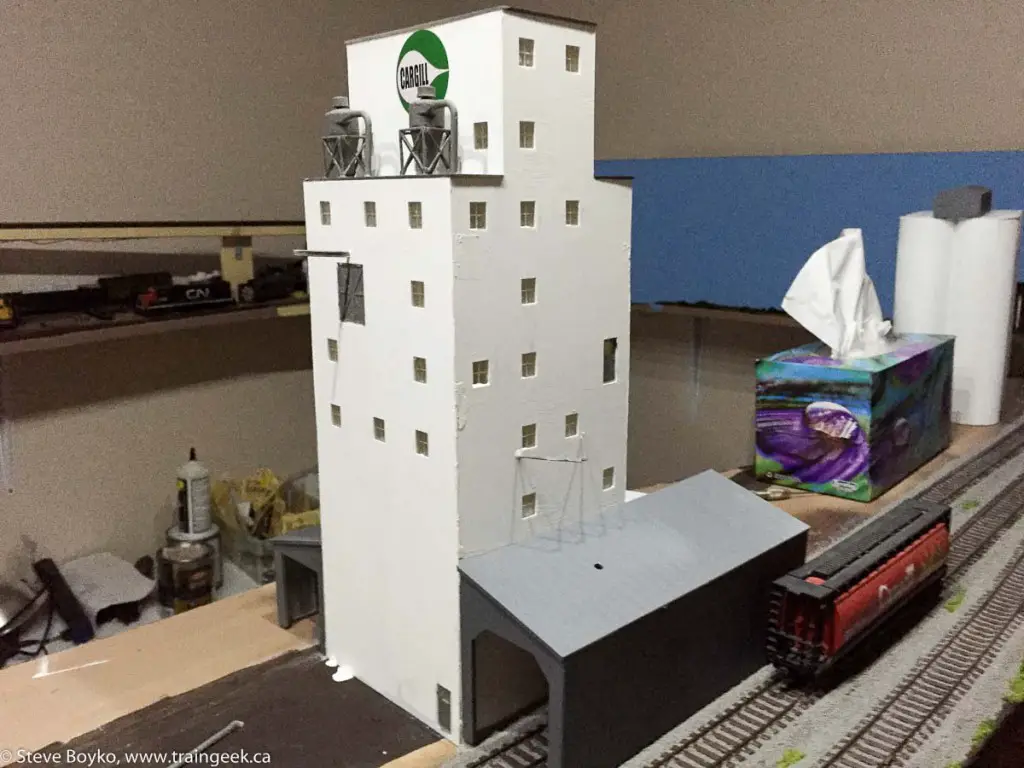
Once the shed was glued in place, I drilled a hole in the side of the elevator for the top of the car loading pipe. You’ll notice the support for that pipe in the photo above. I had to hold the pipe in place while the glue dried (CA this time) so I used a handy holder.
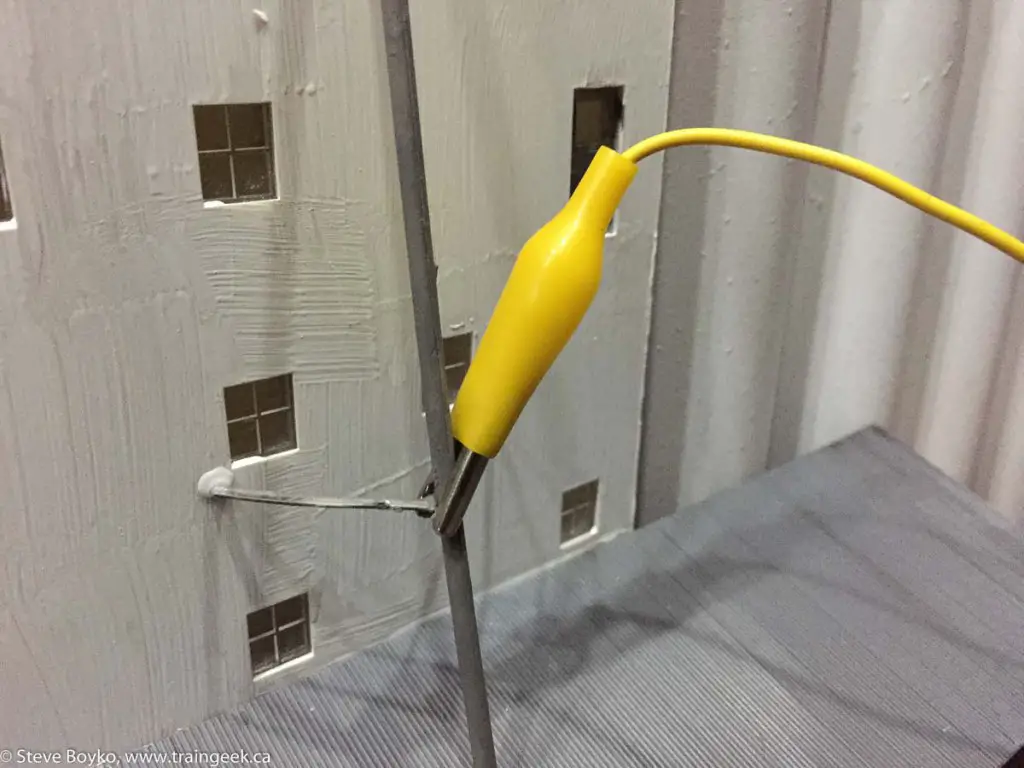
You can see the brush paint here in this closeup. Awful at close range.
After that was weathering and scenery… topics for another time.
Here are my take-aways / lessons learned from building the Walthers concrete grain elevator kit:
- Paint everything before assembly.
- Use gussets or something square on the base to keep everything square.
- Don’t glue structures to the layout if you can help it.
- No-More-Nails is da bomb.
Now the elevator is in service and receiving cars from CN. I’m going to call this a success! 🙂